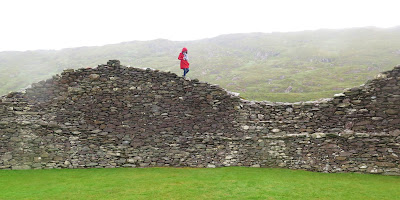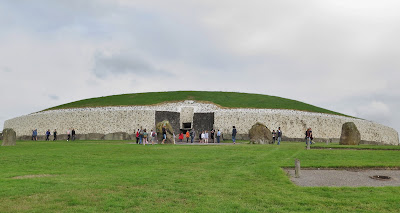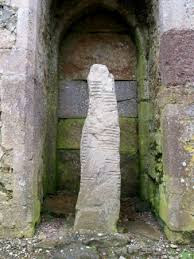From megalithic monuments to early Christian places of worship, Ireland has an extraordinary mix of ancient sites that are unique to Celtic Europe. Mix in Ireland's rugged landscape and epic legends, and you have a mystical experience awaiting you.
"In Ireland, this world and the world we go to after death are not far apart."
 |
| Locations of ringforts in Ireland |
Ireland conjures up images in people's minds of rural green fields and wild coastlines, small colourful villages and charming pubs. The word cozy comes to mind, and even in the middle of summer, the thought of sitting next to a turf fire in the evenings sounds perfect. But what does Ireland FEEL like? Well, that's a bit harder to describe, but I'll do my best. Let's just say the land seems ancient; like it has been walked on by so many different people for thousands of years that their different beliefs and the earth have just bled into each other over time. There are certain places where you can almost feel the land "throbbing" with subtle energy that is perhaps detected as an uneasiness sometimes, or as a sense of peacefulness at other times. These places are usually marked by monuments built by the ancient people and then re-built upon over the various epochs, so a megalithic stone circle became an ancient Celtic stone fort, then an old Celtic-Christian round tower, then a Catholic church (and then a tourist attraction). But the energy remains the same.
 |
| Staigue Fort On The Ring Of Kerry |
The Irish are used to the ancient monuments being literally in their backyards, and I've heard an Irish person call these "The Thin Places." Places where the energy vibrating is so strong, it can be detected by tourists passing through. Places where time stands still or bleeds through to another era. Areas where the veil between this world and the next are almost transparent. Some monuments are not necessarily unique to Ireland, but when you put them all together on one island with the poignant landscape, and the fantastical legends you have a place in the world that can ignite your imagination and curiosity.
Here are some of the ancient wonders you should see...
Ringforts
 |
| Leacanabuaile Stone Fort Near Cahersiveen |
Ringforts are often called Fairy Forts, but they are very much a human remnant. The name in ancient Irish is
Caiseal (or
Cashel in English) and C
athair (or
Cahir in English) both of which are names of Irish towns that had great ringforts of the ancient Irish Kings. There are thought to be about 40,000 ringforts in Ireland mostly dating from around the bronze age. From simple earthen circles to fortified stone fortresses, these rings were protected farmsteads for the clans and their livestock; which was equivalent to their wealth. Depending on the size of the ringfort, several dwelling huts were located inside as well as areas for keeping the animals.
Beehive Huts
 |
| Beehive Hut On Skellig Michael |
The famous little houses that are made of corbelled dry stone are well-known to the Southwest Coast of Ireland. These are called clochán in old Irish, and archeologists believe that these structures came to Ireland with the Celtic people. In later years the beehive huts were associated with Christian monks who then took this building technique to Cornwall and Wales. The earliest of the round beehive houses had thatch roofs rather than stone, and could easily be disassembled and joined with another hut, as we see in some of the ringforts.
←This stone hut is located on the famous Skellig Micheal.
Round Towers
These are my favourite buildings in Ireland! There are about 65 round towers scattered mostly around Ireland, and they served primarily as a bell towers in Celtic Christian churches. The Irish name for the round tower is: "cloigthithe" or bell house in English. The towers acted as beacons for ecclesiastical settlements that primarily consisted of simple little corbelled dry-stone buildings that surrounded the tower. The doors to the round towers are always elevated, therefore giving the circular base of the tower more strength. These Celtic Christian towers were built before the Norman invasion 1169-71, after which Romanesque style churches were erected by the Catholic church.
Stone Circles
 |
| Stone Circle Kenmare |
There are A LOT of stone circles in Ireland...about 187 to be exact. Most of the stone circles are found in County Cork (103 of them!) and about 20 in County Kerry. So if you are into checking out the Stone circles in Ireland, the South West is where you need to head. In fact, the biggest stone circle in SW Ireland is in the town of Kenmare on the These stone circles were erected in the late Neolithic age to early Bronze Age and are of various sizes. Stone circles were used for ritual and ceremony and are generally aligned with the sun at Solstice. I found a few stone circles in Ireland, and the energy in these places was strumming! I can tell you that many of these circles are still used today by those practicing the ancient ways.
Dolmens
 |
| Portal Dolmen |
Dolmens or Portal Tombs are neolithic structures that look like giant standing stones with a large angled capstone on top. These stones would have been covered over in earth like a big mound. There are about 190 stone age dolmens in Ireland today, and they can date back to about 3,000-2,500 BCE. Dolmens were thought to be burial tombs, or Druids alters, or ceremonial centrepieces, but nobody knows for sure and are a bit of a mystery...👻
Megalithic Tombs
 |
| Tour At Newgrange |
Of all the sacred places to see in Ireland, the Neolithic Age Passage Tombs are the most impressive. In the
Boyne Valley just 40 km North of Dublin there are three large passage tombs; Knowth, Dowth and Newgrange that you can tour (with a guide) in the world heritage site
Brú Na Bóinne. These giant mounds of earth are tombs with chambers inside that date back to over 3,200 BCE; older than the pyramids of Giza! You can visit each passage tomb, but access inside is limited to Newgrange where a guide takes you inside the mound, and the winter solstice sunlight is reenacted for the visitors. This is very special, and if you tour only one archaeological site in Ireland-make it this one. For more information on the megaliths of the Boyne Valley check out this informative website
www.carrowkeel.com
 |
| Ardmore Ogham Stone |
Ogham Stones
These are really cool! Ogham (or
Ogam in Old Irish) is an Early Medieval writing system for the ancient Irish language. WHAT? Basically, Ogham is a set of lines that are "letters," and the words are written vertically (bottom to top) instead of horizontally. It is said that the earliest Ogham inscriptions date back to the fourth century CE, but new evidence is surfacing to suggest that the written language is much older around the 1st century BCE. There are around 400 Ogham inscriptions on stones in Ireland, some had been vandalized by Christian monks because of the language itself being Pagan. If you want to see your name written in Ogham, check out this cool
Ogham Transliterator.
Sacred Wells
 |
| St Bridgid's Well In Kildare |
Holy Well, Sacred Springs or in Old Irish a
Tobar (hint: any town names with "tubber" or "tober" like Ballintubber in County Mayo means there is a holy well involved). These wells are places of high power and healing. Many ancient Pagan sacred sites had a well or naturally occurring springs associated with a Deity and later a Saint when Christianity took hold of Ireland. There are holy wells all over Ireland, many wells are listed on the Ordnance Survey Maps. But some Holy Wells are only known to locals so don't be afraid to ask around at the local pub or grocery store. When you visit a sacred well, you may also notice a tree near the water with rags or scraps of paper tied to the branches, this is called a
Clootie Tree. The idea is that you dip your fabric scrap into the well and wash your wound with the clootie and tie it onto the tree (often an Ash Tree which was sacred to Druids), as an offering to the Deity of the holy site. Nowadays people are leaving prayers or wishes written on paper tied to the tree. Check out my blog post on
Saint Brigid's Well in Kildare, Ireland
Ireland. Whether you are researching family history, exploring remote places or are drawn to the island by some unknown force; the mystic feel of this ancient place will touch you at least once on your journey.
Have you ever had a mystical experience in Ireland? I would love to hear about it in the comments below❣
Follow me on FACEBOOK, INSTAGRAM and BLOGLOVIN' for daily photos and updates! #slowtravel🐌 #dulgomall












No comments:
Post a Comment